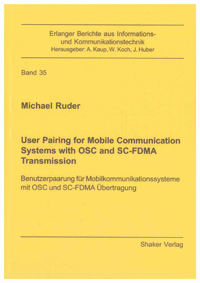
Shop : Details
Shop
Details

January 2015
Michael Ruder
User Pairing for Mobile Communication Systems with OSC and SC-FDMA Transmission
Benutzerpaarung für Mobilkommunikationssysteme mit OSC und SC-FDMA Übertragung
The main subject of this thesis is user pairing for mobile communication systems. User pairing in general describes a user selection process, where we choose the users that should transmit on the same time and frequency resource in the same cell. Typically, user pairing is optimized for a prescribed performance criterion, like bit error rate (BER) or achievable data rate. In this thesis, user pairing is considered for two systems and the spectral efficiency gains compared to randomly chosen pairs are shown to be impressive.
First, we focus on downlink transmission with orthogonal sub-channels (OSC). The evolution of the Global System for Mobile Communications (GSM) led to the standardization of Voice services over Adaptive Multi-user channels on One Slot (VAMOS). The aim of VAMOS is to double the spectral efficiency of GSM voice transmission by deliberately transmitting two Gaussian minimum-shift keying (GMSK) signals on the same time and frequency resource in the same cell. The phase of the signal of the second user is rotated by 90° compared to that of the first user, which is referred to as OSC transmission.
Second, the thesis considers the uplink of Long Term Evolution (LTE). In contrast to the downlink of LTE, the first release of LTE specifies only a single transmit antenna single-carrier frequency-division multiple access (SC-FDMA) transmission for the uplink. To enhance the spectral efficiency in the uplink, a virtual multiple-input multiple-output (V-MIMO) transmission can be employed, where multiple users are paired. Here, multiple receive antennas at the base station facilitate a separation of the signals of a user pair. By employing the proposed schemes, the spectral efficiency is impressively improved compared to a transmission without user pairing.
First, we focus on downlink transmission with orthogonal sub-channels (OSC). The evolution of the Global System for Mobile Communications (GSM) led to the standardization of Voice services over Adaptive Multi-user channels on One Slot (VAMOS). The aim of VAMOS is to double the spectral efficiency of GSM voice transmission by deliberately transmitting two Gaussian minimum-shift keying (GMSK) signals on the same time and frequency resource in the same cell. The phase of the signal of the second user is rotated by 90° compared to that of the first user, which is referred to as OSC transmission.
Second, the thesis considers the uplink of Long Term Evolution (LTE). In contrast to the downlink of LTE, the first release of LTE specifies only a single transmit antenna single-carrier frequency-division multiple access (SC-FDMA) transmission for the uplink. To enhance the spectral efficiency in the uplink, a virtual multiple-input multiple-output (V-MIMO) transmission can be employed, where multiple users are paired. Here, multiple receive antennas at the base station facilitate a separation of the signals of a user pair. By employing the proposed schemes, the spectral efficiency is impressively improved compared to a transmission without user pairing.
Keywords: User pairing; LTE; Mobile Communications; SC-FDMA; GSM; V-MIMO
Erlanger Berichte aus Informations- und Kommunikationstechnik
Edited by Prof. Dr. J. Huber, Prof. A. Kaup and Prof. Dr. W. Koch, Erlangen-Nürnberg
Volume 35
Available online documents for this title
DOI 10.2370/9783844032901
You need Adobe Reader, to view these files. Here you will find a little help and information for downloading the PDF files.
Please note that the online documents cannot be printed or edited.
Please also see further information at: Help and Information.
Please also see further information at: Help and Information.
| Document |  | Document | ||
| Type |  | |||
| Costs |  | 37,35 € | ||
| Action |  | Purchase in obligation and download the file | ||
| Document |  | Table of contents | ||
| Type |  | |||
| Costs |  | free | ||
| Action |  | Download the file | ||
User settings for registered online customers (online documents)
You can change your address details here and access documents you have already ordered.
User
Not logged in
Export of bibliographic data
Shaker Verlag GmbH
Am Langen Graben 15a
52353 Düren
Germany
Am Langen Graben 15a
52353 Düren
Germany
Mon. - Thurs. 8:00 a.m. to 4:00 p.m.
Fri. 8:00 a.m. to 3:00 p.m.
Fri. 8:00 a.m. to 3:00 p.m.
Contact us. We will be happy to help you.

